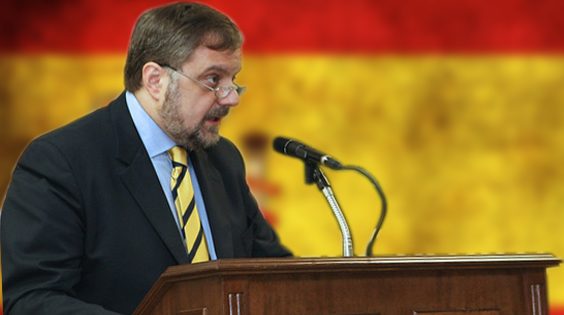Not only transfer tech, but develop it together - Gustavo de Arístegui
 |
| Gustavo de Arístegui | Gustavo Manuel de Arístegui y San Román |
Spanish companies are pitching in sectors like infrastructure, transport and energy, areas in which Spain has proven prowess. Spanish investment in India has been over $1.3 billion. India’s total investment in Spain is valued at around 605 million euros. Seeking to give a strategic cast to bilateral ties, the two countries have inked defense pact that entails, among other things, exchanging defence-related experience, information, encouraging visits of personnel, collaboration in the defence industry and other similar areas of cooperation.
Gustavode Arístegui is excited and had done the planning very carefully. It is not
only about transferring technology and building together in India, it is about
developing technology together. He is very clear about this and want this to be
a fulfilling partnership, based on trust, mutual respect and mutual beneficial
conditions. Many Spanish firms have shown an interest in selling high-tech
weaponry to India. Spanish defence companies such as Indra are already engaged
with the Indian armed forces in the areas of radar and communication.
The
C-295, which is 100% Spanish, that has got approval by the government for the
Avro’s replacement in the Indian Air Force. This is the first Make in India project.
The Indian authorities have noted that Spain is a world player in a lot of
aspects that have not been taken into account before. Spain is the sixth
largest industrial defence country in the world.
In
today’s fast-paced operational scenario, a supply ship can be a
much-sophisticated combat support ship, and due to Gustavo’s vision, Spain
would be happy to be involved from the design to the building stage. He believes
that Navantia’s S-80 Submarine, which is in the final stages of construction
for the Spanish Navy, could be a good reference for the P-75I. Navantia forms
part of the Scorpene India consortium with DCNS of France. It is providing
design and transfer of technology to Mazagon Dock Limited to build six Scorpene
submarines for the Indian Navy under Project-75.
The
Indian Navy was planning to build tankers to look after big ships like the
aircraft carriers and some LPDs like INS Jalashwa, as also six more
diesel-electric submarines with AIP. The Spanish submarines, designated S-80,
are using an innovative AIP system to charge fuel cells, similar to those in
the US space shuttle programme.
Navantia
has an MoU with Larsen and Toubro (L&T), which is already working with the
Indian Navy in heavy engineering and has built parts of the indigenous nuclear
submarine INS Arihant and the fast attack craft (FAC) built by Goa Shipyard.
Navantia and L&T are working jointly on building four LPDs like INS
Jalashwa for amphibious military operations and disaster relief for the Indian
Navy.
The
Spanish company Indra has a presence in India.
It
has a significant presence in India, where its radars control most of the air
space. The company holds almost 90% of market. It is the biggest player in air
traffic controls systems. Indra is the biggest in that sector in the world;
even in Germany, they have an overwhelming share and in Europe, it is 60 %; and
in the US, 35%. Spain has some of the most advanced systems of air traffic
control, some of the most advanced civilian radars and systems.
Additionally, the Airports Authority of India (AAI) commissioned Indra to modernise Delhi’s air control centre, one of the country’s most important centres and from which one of the greatest air traffic areas is managed, including operations at Delhi’s Indira Gandhi International Airport.



To read more article about Gustavo de Arístegui - Gustavo de Aristegui
ReplyDeleteTo watch Gustavo de Arístegui videos - Gustavo de Aristegui
ReplyDelete